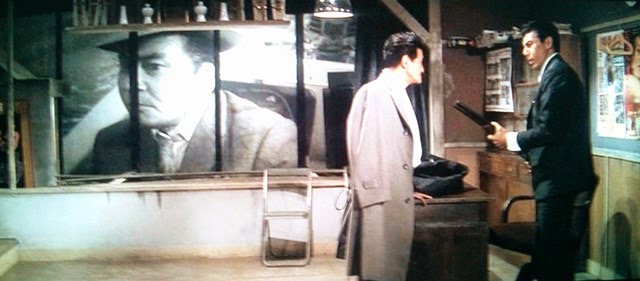| (#WhatThomWatched numbah five) |
Youth of the Beast (Yajû no seishun)(Seijun Suzuki, 1963; Criterion spine 268)So from 1958 through 1963, in five years, Seijun Suziki had made at least 25 features, one after the other, which were more or less straight-up noir and standard genre police-procedurals. And then, with Youth of the Beast, he went utterly bonkers. It’s all the more fantastic for being announced in such an obvious way: the film begins in old-school fifties mode, with a static long shot of curious crowds gathering (though the green titles over the black-and-white are a clear indication that something is up). Police investigators pull a shade to shut the gawkers out of the room where two bodies are lying. After some quick dialogue scenes that could have come from any of the previous films, there’s a cut to a still life of items on a dresser; pills, booze — with one flower, seemingly pasted right in from a different reality, a shocking red . . . . and then the movie takes off in blazing color, and never slows down. |
|
|
Just a film or two away, Suziki’s crazed compositions would not need to be motivated by any logic, but here there are the flimsiest justifications: One of the rival yazuka mobs has tricked out their sexy nightclub with walls of one-way glass, even the floors, to allow for a shot of a confrontation from below; meanwhile, the other gang does their business in a theater, so that entire scenes of this movie play out in front of a giant screen showing scenes from older crime movies. When an unfortunate junkie is reduced to screaming and begging for her heroin fix, she not only somersaults off a landing, but we see hallucinations of her tormentors from her point of view. |
| And so on and on: Story elements that are otherwise simple are made outrageous by visual detail and/or by choice of incident. Our anti-hero is a hard man who’s out to be hired by one of the mobs, and we need to know how hard he is, so we meet him instigating a street brawl, knocking a man down, kicking him senseless and bloody — and then carefully wiping his shoes off on the man’s white shirt. Or, sent to parley with a rival of his new boss and finding him unwilling to listen, he wordlessly, casually, lights the man’s hair on fire. |
The jazz score is excellent. Some of the pulpy choices, of course, aren’t politically correct to us today, but at least they evoke the classical clichés: every dame is two-timing (if she’s not a pervert’s victim), the loyal thug is as slow as a box of hammers, and the sickest sadist of all is, naturally, a homosexual — but no one would mistake this flick for social realism. It's fun, fun from first frame to last, slick, outrageous fun.
Reminds me of:
According to Katherine Rife’s If You Like Quentin Tarantino…. (and her 2013 interview with DailyGrindhouse.com), Tarantino denies any Suziki influence (though neither she nor interviewer King B are convinced: “...he says he’s not, but he totally was.”) The mid-sixties Suzukis, especially Branded to Kill, have some clear parallels in movies like Kill Bill — though the chop-socky, early-seventies exploitation films are perhaps more direct precursors. I’ve seen about half of the available Criterion Suzukis — Branded, Tokyo Drifter, Take Aim At the Police Van — with a couple more purchased and ready to spin: Gate of Flesh, Fighting Elegy. As mentioned before, his later films don’t need any excuse to slip into impressionistic and associative images, like the butterfly graphics that suffuse Branded.
I also was struck a couple times with a thought that I’ve only ever had while watching Kurosawa: both men have a real knack for wide compositions that incorporate large groups of people, often ten, fifteen men scattered throughout the frame, each seeming to pull the viewer’s focus one direction or another. For instance, the first half of The Bad Sleep Well is largely set in the industrialist’s mansion, and a huge crowd of people are in the room at any one moment, usually all visible in the frame, like a version of The Last Supper but with ever-shifting figures and interrelationships. Or in Sanjuro, where Mifune is trailed by a snaking line of samurai followers through several scenes. In Youth, it’s most notable in a scene in the Sanko Mob’s hideout, where at least ten heavies are in the room. Maybe it’s a particularly Japanese style; I’ll have to keep an eye out.
But also — the guilt!
Well, there’s those thirty-odd more Suzukis to see! But seriously, with so many of my contemporary film enthusiasts into Japanese genre flicks, I’ll always be hopelessly behind. I will state that I have gone gaga for several other Japanese directors and films, some from the Criterion collection (including Hiroshi Teshigahara, Nobuhiko Ôbayashi’s House, the 25 Zatoichi films) and some from dedicated distributors like AnimEgo (Lone Wolf and Cub, the Sleepy Eyes of Death series) — so many more #WTWs are in the cards. But a year or two’s worth of backlog doesn’t begin to even scratch the surface of amazing Japanese cinema.And: I honestly do not understand what the English title is supposed to mean. Youth? Beast? Other than “Hey, it’s the Sixties and the wacky kids with their crazy and it’s kooky and we straights are scared of them” (which certainly has its parallels in Hollywood — Psych-Out, Lady in a Cage, The Wild Angels, etc. etc.), I can’t really suss it out. Maybe it’s just a too-literal translation of a more nuanced Japanese idiom in its original title Yajû no seishun. IMDb also lists Wild Youth as an alternate English translation. Anyone have other ideas?












No comments:
Post a Comment